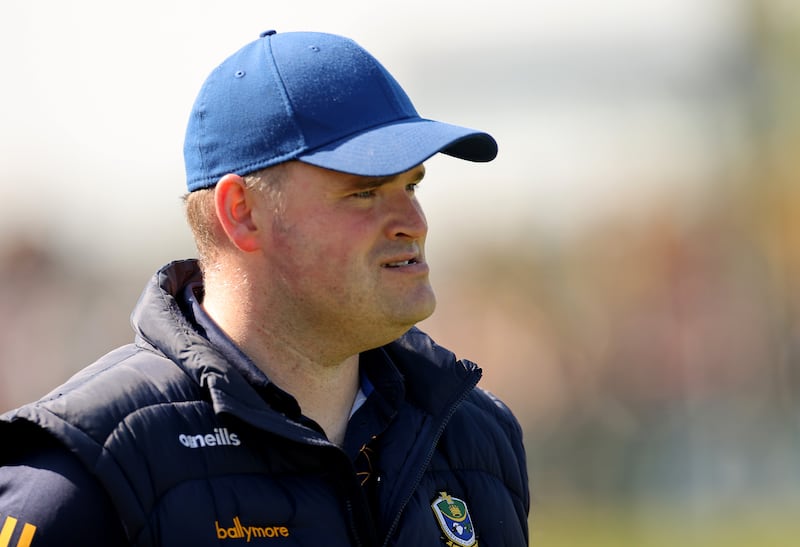Hang it in the Louvre, as the cool kids like to say these days.
There might not be much available real estate within the museum after the recent installation of the extensive Jack Grealish collection of modern art, but Kildare folk would argue Kevin Feely’s contemporary assemblage still deserves a spot in the gallery.
In particular, his majestic leap for the match-winning mark in Sunday’s All-Ireland SFC contest against Roscommon. It was technically outstanding and wonderfully executed – the clip of Feely getting airborne and fielding the ball high above his head is coming to a coaching workshop near you soon.
The nerve and skill he displayed to then nail the resulting kick was a fitting conclusion to a masterful passage of play by Feely. But the image of him sailing through the sky, that’s the clinker.
Inside Gaelic Games: The weekly GAA newsletter from The Irish Times
Dublin job is Ger Brennan’s to turn down, while Gavin Devlin is well placed to land Louth role
‘Tipperary are coming’: Liam Cahill guides Premier hurlers back to Croke Park after six-year absence
Ciarán Murphy: Football’s best forwards are being rewarded for their genius and it’s a joy to behold
It was exactly the kind of moment the inside mark (forward mark/attacking mark/whatever you are having yourself mark) was introduced for, to encourage, long kicking and high fielding. Daniel Flynn floated the pass inside from just on the 45-metre line with Feely catching the ball marginally inside the 13-metre line. The fact it was in the dying seconds of the game amplified the brilliance of the catch.
But Feely’s spectacular mark is the exception to the rule. The inside mark has not delivered truckloads of such scores, it has not rekindled the rose-tinted glory of the catch and kick game, it has not made Gaelic football better. If anything, it has been a contributing factor in slowing the game down. It is a needless mark.
And fans of the needless mark will now forever guide critics of it in the direction of Feely’s work of art, and against only that example you might be as well off trying to paint Man City’s treble as the heartwarming story of a plucky underdog.
But try drawing up a top 10 list of points scored from marks in Gaelic football since its introduction and it might take you a while to get there. The needless mark has not led to an increase in long-range passes, but rather we have seen a proliferation of the dinked ball to the chest instead.
As Kildare and Roscommon squared off in Tullamore on Sunday, their round-robin group counterparts Dublin and Sligo met in Cavan. In the fourth minute of that game, Dublin found themselves moving the ball laterally across the Sligo 45-metre line.
Eventually they advanced inside the 45, but Daire Newcombe didn’t fancy venturing any further and instead recycled the ball back out with a short pass to Seán Bugler, who then offloaded to Lee Gannon. The ball was now back outside the 45. Gannon played a lateral pass across to Brian Howard, who collected it about 20 metres in from the sideline.
Howard looked up, noticed John Small unmarked just inside the 45 and popped the ball to the Ballymun man’s chest. Small, as was his right, immediately jabbed a hand skyward to signal he was taking a mark. The whistle sounded more like the air seeping from a balloon.
We have seen far more of those marks than the one Feely sculpted in the closing moments of Kildare’s match last Sunday, because the rule allows for popped balls across the 45 to be called as marks. More often than not the inside mark slows down the game, sucks energy out of the contest, allows teams get themselves set up and so the game becomes more pedestrian and structured. The inside mark is a dollop of treacle.
The official regulation states: “When a player catches the ball cleanly on or inside a 45m line from a kick in play (i.e. not from set-play) delivered by an attacking player on or beyond the opposing team’s 45m line, that travels at least 20m and without it touching the ground.”
The Kildare-Roscommon game was an outlier in several ways, but it did show the potential benefits for teams utilising the mark. Kildare scored five points from marks on Sunday – with three different players on target. One of Roscommon’s score also came from a mark, so six points in total were as a direct result of marks.
In the other seven All-Ireland SFC games over the weekend, there was a combined total of six points scored from marks. There were no scores from marks in four of the eight games.

Prior to the Kildare-Roscommon match, Rossies manager Davy Burke had been pretty clear in his opinion on the mark, labelling it an ‘absolute joke of a rule’ and adding that he would ‘get rid of the attacking mark in the morning’ if he could.
Burke then watched his native county go to town with it against Roscommon.
“It’s a strength of Kildare and fair play to them, they used it well,” he said. “We got one or two for the first time all year as well, it is what it is I suppose.”
But it doesn’t need to be. The game is not better because of its existence.
In the 21st minute of this year’s Leinster final, Cormac Costello spotted Con O’Callaghan in a one v one situation in front of the Louth goal. From well outside the 45-metre line Costello launched a delivery with O’Callaghan catching the ball in behind his marker, but slightly to the right of the posts.
If there was no mark available there is little doubt O’Callaghan, who is one of the most powerful and direct runners in the game, would have immediately starting drilling towards goal. Instead, he raised his hand and what was a growing ripple of excitement immediately turned to deflated sighs around Croke Park.
Feely’s catch and kick was engaging for so many reasons, not least the recent battle he has fought to return from injury. It was brilliant to see one of the best fielders in the game perfect his art after such a difficult period.
But we shouldn’t allow one exceptional moment to be a coat of gloss that covers over the flaws of a rule that has brought more dullness than vibrancy to Gaelic football.
So, yes indeed, put it in the Louvre. Or the Uffizi. Or even the one in Croke Park.
For there can be no more appropriate place for the inside mark than a museum.














